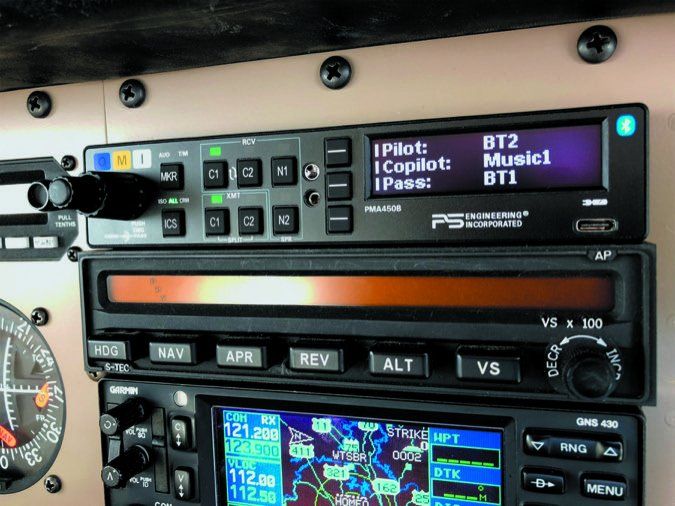PS Engineering says the features and functions in its latest PMA450B flagship audio panel are the result of its 33 years concentrating on nothing else but designing aircraft audio controllers. Plus, it listened to what pilots (and installers) want in a modern system and put it all together to not necessarily create a revolutionary panel, but an evolutionary one.
As we’ve said in previous reviews, Tennessee-based PS Engineering is not one to let its products go stale. This philosophy comes across loud and clear in the PMA450B, an advanced version of its original PMA450. We put the system on our evaluation bench, cranked up the headsets and put it through the paces.
Highly Configurable
The PMA450B’s OLED (organic light emitting diode) graphics display is integral to operating nearly all of the panel’s higher-level functions, including its configurations. With so many advanced functions and customizable settings, we think incorporating a display in the UI is imperative. PS Engineering did a good job of keeping the menu structure shallow and while some users will need to reference the pilot’s guide for setting up advanced functions, basic operation is simple.
The panel will come on with the master avionics power, but the small rotary knob serves double duty as a power control (it’s a push-in-and-hold switch to eliminate inadvertent power cycles) and pilot/copilot intercom volume. The larger knob is for passenger volume. Green LED bars to the left of the knobs illuminate when you turn the knobs, showing relative volume. The volume controls are linear throughout the range and there was more than enough gain through our Bose A20 headset.
Four bezel buttons control comm radio transmit/receive. The bottom row is for transmitting and the top is for listening. There are also dedicated keys for VHF nav radio audio. That’s enough to get you flying, but there’s a whole lot more.
The PMA450B makes it possible for serious amounts of user customization, but before you begin you’ll need to understand some basics for working with the PMA450B’s menu. In our evaluation we found that the feature set is quite deep and we think some users will be intimidated by it. But understanding some small nuances takes out some of the mystery and finger fumbling.
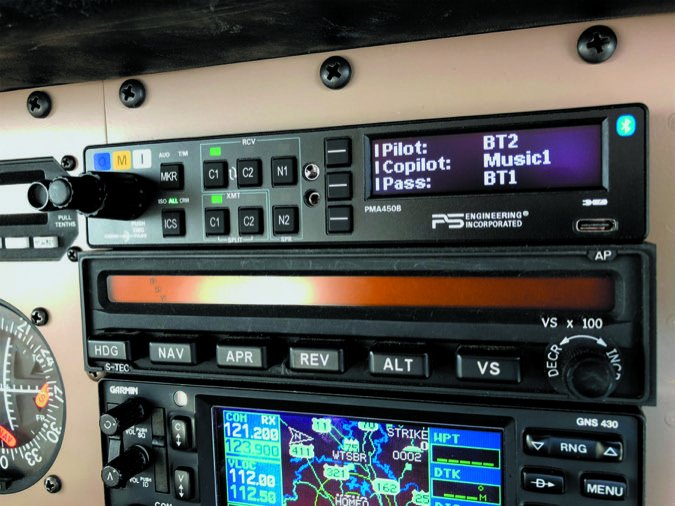
The OLED display has three line-select buttons to access a variety of functions, including custom configurations. Simply press the line select button to select an item on each menu. When menu hopping, the screen automatically returns to the Home screen after a period of inactivity and the delay time is configurable, from one to 30 seconds. Ten seconds seems to work the best, although you might set the timeout for a longer duration as you learn the system. There’s also a display brightness adjustment.
There is an easy clue for recognizing how deep a given menu is. For example, a small vertical onscreen bar next to a function key (and to the left of the menu item) means that key performs a single function on the menu screen. A split bar indicates that a secondary function is available when you hold the key in for longer than one second. In other words, there are more options hiding in the second level.
The panel has a USB-C charging port on the bezel capable of providing 5 VDC (3 amps of current at 15 watts) to charge smartphones and tablet computers. PS Engineering offers cables to fit a variety of devices.
The six-place intercom in the PMA450B uses PS Engineering’s IntelliVox squelch control, which is completely automatic and uses signal processing at each microphone. By sampling voice and ambient noise, the processors open and close the squelch with impressive precision, as long as you keep the microphone against the lips, or close to them.
The intercom has three isolation modes, including all, pilot isolate and crew isolate. But these old-hat functions are what you would expect as standard in any modern audio system.
The panel has many user-adjustable functions in its setup menu. For one, you can rename the switched audio inputs from the default ADF and DME. Since many users don’t use this equipment anymore, you can rename/customize the input sources (using up to nine characters) to correspond to audio alerts coming from other equipment, including GPS navigators and traffic alerters, to name a couple.
With a function called Flightmate, the panel has four discrete messages that can be triggered by external systems (engine monitors and landing gear alerts, for example) when they’re wired in. On a side note, don’t assume your shop will wire these discretes in as standard. It will mean additional effort, but we think it’s worth it—especially when the panel is opened and the wiring is accessible. Engine monitors from JP Instruments and Electronics International, to name two, transmit these discrete outputs when wired accordingly.
The number one alert is designed for priority and will continue to play until whatever is triggering the condition clears. Alerts two, three and four can be stifled by pressing the Acknowledge soft key. You can record custom alerts in your own voice by speaking them into the microphone. Some examples include “check oil pressure” and “check fuel.”
There are other prompts in the upper right portion of the screen that show the status of Bluetooth connection, the connected device’s battery status and whether or not a music source is active.
Dimensional Audio
Just like early versions of the PMA450, the current one has PS Engineering’s IntelliAudio. The tech is licensed from the U.S. Air Force, which developed the function as an intuitive way to process headphone audio after recognizing its pilots are inundated with multiple audio signals at once.
When it’s turned on in the PMA450B (accessed from the lowest line select key) comm radio audio signals are digitally processed to appear in different locations in the headset. Maybe you want ATIS or approach control from the second radio positioned at the 3 o’clock position and the primary radio at 9 o’clock. When in Auto mode, IntelliAudio reverts to normal when one of the radios goes quiet, and separation returns when both are active. The HRTF (head related transfer function) allows the user to relocate each comm radio to one of nine defined locations using a simple onscreen graphic that shows where each radio will play. You’ll need stereo headphones for the function to work, and intercom audio cannot be spatially adjusted—a good thing, in our view, for the sake of simplicity. The function can be turned off entirely.

It’s important to stress that HRTF doesn’t increase the audio volume, but for pilots with hearing impairments, repositioning the audio (there are selectable near and far fields) closer to the ear can help.
While not a function of HRTF, we like the smart comm monitoring mode. This mutes the secondary comm radio audio when the one being used for transmitting has an incoming call. If you’re always cranking down the ATIS audio when your primary radio has incoming chatter, this function is for you and us.
Bluetooth, Recorder, Timers
The panel has two internal Bluetooth modules (BT1 and BT2) and sizable amounts of smart configuration can be done when connecting. Since the panel can stream data from two independent Bluetooth sources at the same time, one can be used for streaming music and the other can be used for streaming audio out to select action cameras. We’ll get to that shortly.
The first thing you’ll want to do before setting up your smartphone/tablet and configuring the panel to your liking is unpair all devices to erase them from the panel. The default pass code (PIN) is 0000, but you can change it. Some Bluetooth phones won’t pair if a PIN is required, so the panel gives you the option to disable it.
The entertainment input capabilities of the PMA450B are impressive. There are four possible independent music inputs: Bluetooth one, Bluetooth two, music one and music two (these are hardwired inputs either via cabin input jacks or from a remote music source like Garmin’s GDL69A SXM receiver). As with other PS Engineering products, these inputs can be configured so the music sources mute with aircraft radio and intercom chatter. This is custom configurable for pilot, copilot and passengers.
The default setting mutes (Mute On) when there’s chatter, but you can tell the panel to remember your last preferred mute setting every time you power the system up by turning on the Recall Mute function.
If you fly with non-pilots in the right seat, PS Engineering takes the interface one step further with the Copilot As Passenger feature. When it’s active (it’s annunciated as CPX in the upper right corner of the display)and when the Recall ICS function is turned on, the copilot audio station will behave like a passenger seat on the intercom at each power up, unless you turn CPX off. Even the push-to-talk switch is disabled. Think of it as putting the right-seater in a back seat, where some might belong.
The music volume control for crew and passengers is located in the Entertainment menu. While this really isn’t difficult to get to, we still wish there was a dedicated volume key on the bezel. When we griped about it, PS Engineering told us there simply wasn’t room for another button. We suggest losing the marker beacon select key, or offering a version that doesn’t have marker beacons.
The Bluetooth telephone function is hands down the smartest we’ve seen on any audio panel. Since the panel syncs with the contacts in your phone, when the phone rings an incoming call menu opens that shows who is calling. You answer the call by pressing the line select key on the display and then talk in full duplex.
The PMA450B has an internal audio recorder that stores the last incoming audio from the radio that’s selected for transmit. It stores up to eight incoming messages and up to 45 seconds of audio. Only the pilot and copilot hear the playback—passengers don’t. Playback is simple: Press and hold the Com receive pushbutton associated with the active transmitter. You can hear all of the stored message or stop it short by holding the Com button for two seconds—handy for verifying assigned headings, frequency changes or for making sure that radio call was for you.
There’s also a built-in timer with count down and count up functions, accessed from the bottom line-select key in the main menu. Press the Set button and use the outer rotary knob to select minutes and the inner knob for seconds. The display reverts to normal and as the countdown progresses, the display momentarily shows the remaining time as the interval is divided in half. When there’s one minute remaining, the system issues an audible alert of “One Minute,” the display counts down the last 10 seconds and a final audible alert says “Time Expired.” The count up timer counts to 99 minutes, 99 seconds from the time it’s started.
Streaming To An Action Cam
PS Streamer is a built-in audio module that streams Bluetooth audio out of the panel. PS Engineering said the interface is compatible with GoPro action cams that have a SENA adapter, plus later-gen Garmin action cameras. To stream Bluetooth from the panel, you configure the second Bluetooth module as an output. Then, set the Bluetooth 2 setting as Streamer and pair it with the camera via the Streamer configuration menu. It takes some button pushes. The Streamer mode is annunciated in the upper right corner of the display using a familiar Bluetooth symbol, but with a flag on it.
Speaking of streaming audio, the PMA450B has a public address mode for talking to passengers over cabin speakers. It’s accessed by pressing and holding the N2 (nav) button. This changes the mode from cabin speaker to PA speaker. When the pilot is speaking on the PA, all intercom audio (except for pilot) will be disabled. The pilot hears his PA transmissions in the headset and keys the system with the push-to-talk switch. Through all this, the copilot has full access to the selected comm radios.
If you want to wire in a satellite phone, the PMA450B should be compatible, but you can’t answer or hang up the phone through the audio panel. While the panel can accommodate a wired and Bluetooth telephone input, only one can be active at a time. The wired telephone function screen (where you adjust the sidetone and volume) activates when it senses audio from the phone. The menu switches off 25 seconds after the incoming call ends, or when pressing End.
A Bit About Installation
Don’t underestimate the amount of effort it will take to install the PMA450B, especially when interfacing with engine monitors and other systems. As for audio quality, be prepared to accept that the overall audio quality of any audio system is greatly dependant on many factors—some of which have nothing to do with the avionics system.
If you go into a major installation with charging system-induced and other electrical noise present, don’t count on the near-flawless sounding PMA450B to fix it.
In many cases, do count on a call from your installer who wants to do some rewiring. Sometimes a gut job that removes all existing wiring is in order and worth the investment.
Too Much Panel?
We asked PS Engineering founder Mark Schauer if the features packed into his latest $2595 flagship PMA450B are more than some might want. “Maybe, but that’s why we sell the $995 PMA6000B,” he chuckled. He’s right. PS Engineering covers a wide swath of market with a diverse product line. It’s also an OEM, supplying the audio system in the Pilatus PC-12NG turboprop.
As for installation costs, it’s not uncommon for many projects to yield sizable invoices, especially when factoring the removal and reinstallation of complex interiors to run new audio jack wiring. A Baron 58 owner reported an installation that topped $7000, while the shop also installed a new GPS navigator and ADS-B transponder.
In our estimation, PS Engineering brand satisfaction is high and its newer panels make for happy passengers. Got an earlier PMA450A? Reader Wally Magathan told us he bought one for his Cirrus to replace the Garmin GMA340 (it’s plug-compatible), and the factory recently upgraded the software for free. That added the CPX and the timer functions. “The Copilot As Passenger feature is a welcome refinement because I can I isolate my wife who sits in the right seat so the radio chatter doesn’t bother her watching movies on an iPad,” he told us.
The PMA450B’s nearest competitor is the $2395 Garmin GMA350c, which has Virtual 3-D audio processing, Telligence voice command when it’s paired with a GTN750 navigator, plus a feature set that focuses on Bluetooth connectivity, entertainment and audio alerting. We’ll see how it compares to the PMA450B in an upcoming review.
Contactwww.ps-engineering.com.
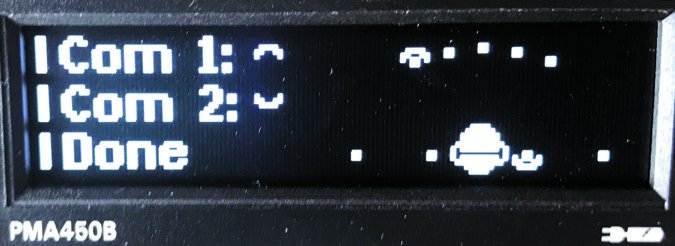
The screenshot above is one of many spatially processed dimensional sound configurations. Notice that Com 2 is positioned at the 3 o’ clock near location, which is directly at the right ear. Com 1 audio is positioned at the 10 o’ clock position, above the left ear. These adjustments are made by repeatedly pressing the corresponding Com line keys.
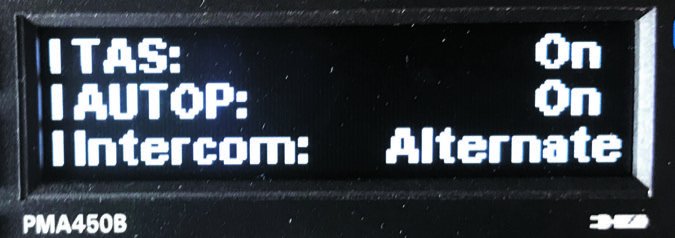
The two switched input sources in the top two line positions were custom edited for TAS traffic and autopilot disconnect. In the Alternate intercom configuration, everyone who is plugged in is active on the intercom, but passengers hear no comm radio chatter. When the comm radio is active, the pilot and copilot won’t hear the passengers. Think of this as an automatic Crew mode.
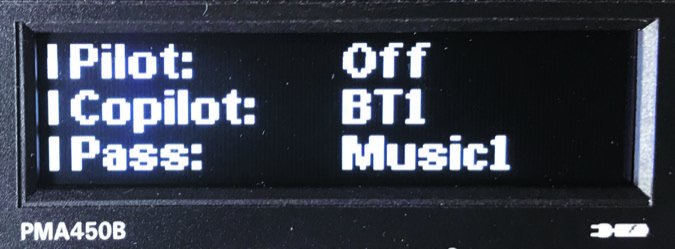
This is the Music Distribution menu, which is set so the pilot hears no music, the copilot is connected with a Bluetooth device (two can connect at once) and the passenger hears audio from a hardwired music source or from a cabin input jack (two can be connected). This isn’t just for music. One practical use might be to stream the music from a smartphone and stream audio alerts from an app, via an iPad.

